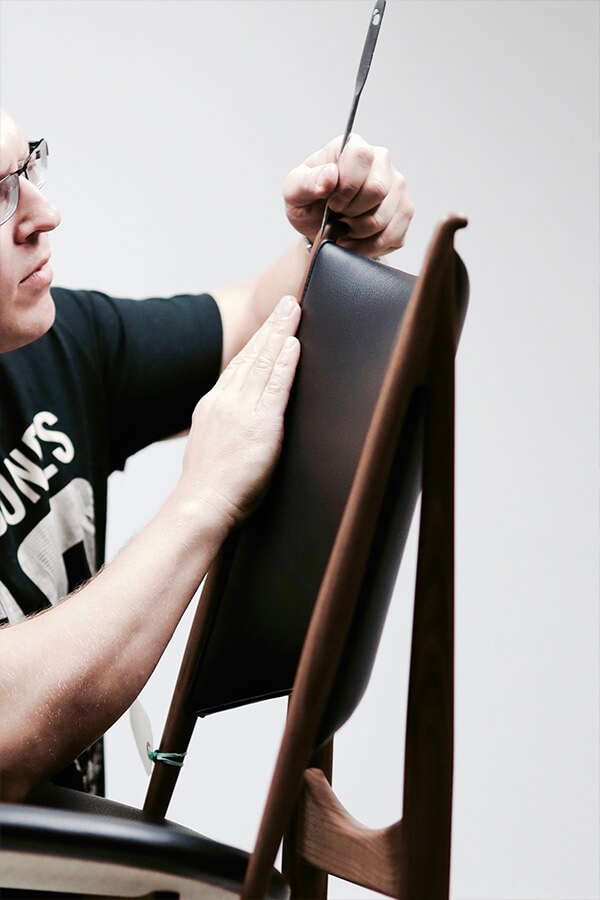Design icon: House of Finn Juhl Chieftain Chair
Designed by Finn Juhl in 1949, the iconic Chieftain Chair is a masterpiece of organic design. Challenging the strict functionalism of the modern furniture movement, it earned it's designer international recognition as the father of Danish Modern style.
Emerging from the golden age of Danish design, Finn Juhl challenged conventions to create organic, often sculptural pieces of furniture that pushed the boundaries of traditional Danish furniture design. In the year it turns 70, we take a look at his most iconic piece: the imposing Chieftain Armchair.
The man behind the chair
Born and raised in Copenhagen, Finn Juhl studied Architecture at the Royal Danish Academy of Fine Arts. While still a student, Juhl was employed by the architect Vilhelm Lauritzen, one of the figureheads of Danish functionalism. It was here that Juhl had his first foray into interior design, becoming involved with the interiors of Copenhagen’s Radiohuset alongside designer Viggo Boesen (who went on to design the Little Petra Lounge Chair).
Within interiors, Finn Juhl had found his calling. Compared to many of his fellow designers at the time though, he faced a big challenge – with no formal education in furniture design and knowing little about joinery, how could he translate his designs into real pieces of furniture?
In a stroke of luck, Juhl met Niels Vodder, a highly skilled cabinet maker. In 1937, in collaboration with Vodder - Juhl exhibited his furniture for the first time at the Cabinet Maker’s Guild in Copenhagen alongside notable designers that included Hans J. Wegner, designer of the iconic Wishbone chair. The start of a collaboration which would last for more than 20 years, Niels Vodder translated Juhl’s drawings into furniture of the highest quality, ultimately leading to the creation of the Chieftain Armchair in 1949.
A majestic armchair
Recognised across the world, the Chieftain is an icon within Danish furniture design. Defined by its organic form and luxurious leather upholstery, this large armchair lets you sit comfortably in a multitude of ways. It is a statement piece that exudes grandeur.
“I started drawing the Chieftain Chair one day in the spring of 1949. I was at home, and I started drawing a small sketch around 10 AM with just four vertical lines connected to something. By two or three o'clock in the morning, I had painted it. But in reality, I don't know how long it took me to design that chair. Perhaps I had a vague idea for some time that I wanted to design something bigger. There had been so many small, handy chairs, so I probably felt like designing something a bit more pompous...” – Finn Juhl
Composed of curved, shell-like pieces that sit on a delicate wooden frame, the Chieftain was revolutionary in terms of its highly-skilled construction. This clear separation of the supporting frame from the seating elements allowed Juhl to mould the supportive parts of the chair to the shape of the human body, creating a design that is extremely comfortable and unique in its form.
Juhl also took a lot of inspiration from ancient cultures. Working to his own definition of ‘functional design’ that embraced aesthetic detailing, Juhl designed the Chieftain to have a drop like carving at the top of the rear legs - a beautiful, intricate detail directly inspired by ancient Egyptian furniture.
The Chieftain chair today
After years out of production, in 2001 Ivan Hansen & Hans Henrik Sorenson – two furniture geeks from Denmark set up the House of Finn Juhl to bring the Danish designer's iconic pieces back into production.
Remaining an incredibly difficult and costly chair to produce, the House of Finn Juhl employ only the most highly skilled craftsmen to produce the Chieftain Chair. The intricate wooden frames are now produced in Japan before being shipped to Denmark to be upholstered in the finest leather. Each Chieftain Chair is stamped with Finn Juhl’s signature and features a badge identifying the House of Finn Juhl as its producer.
Having been awarded the ‘Danish Design Award – Classic’ title in 2012, the Chieftain chair remains as awe-inspiring today as it did when it was first designed 70 years ago. A stunning, timeless showpiece found in homes and businesses around the globe – even Barack Obama has sat in a Chieftain Chair.
Inspired by Finn Juhl? Visit our designer page to discover the full range of Finn Juhl designs and to find out more information about the products. To talk to one of the Nest team, please email info@nest.co.uk, call 0114 243 3000 or send us a message on LiveChat.


House of Finn Juhl
Chieftain Chair
Shop now







